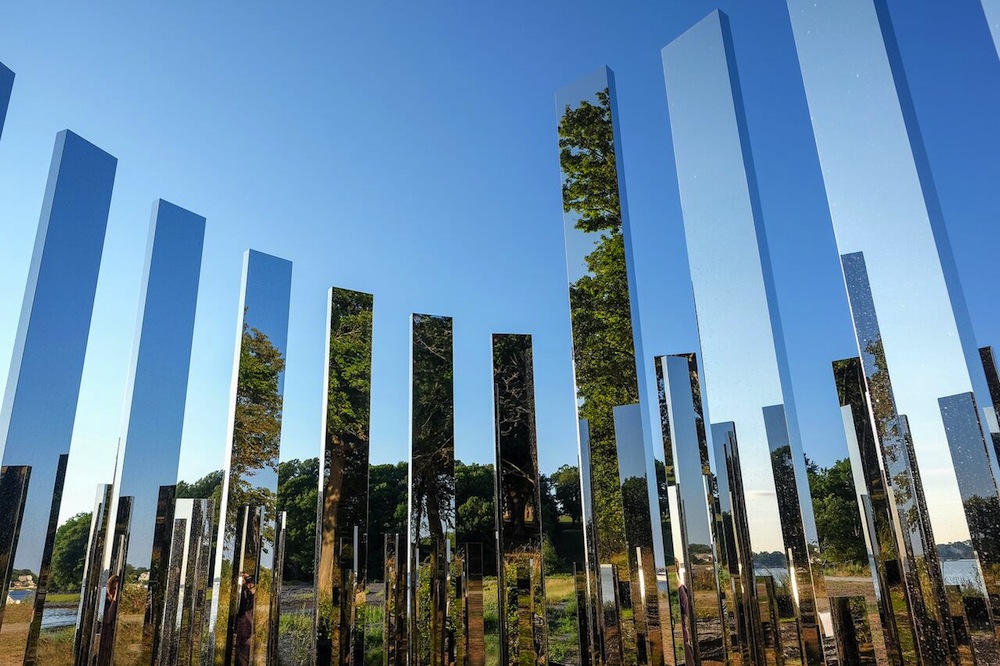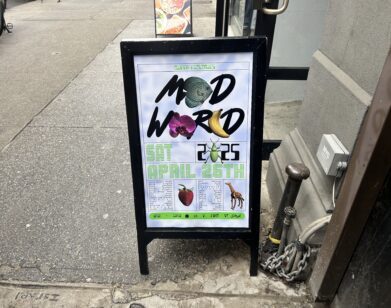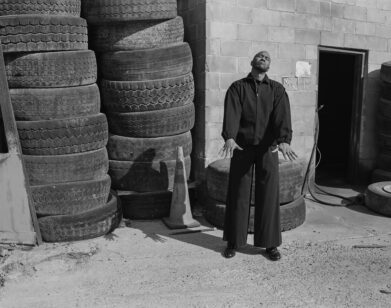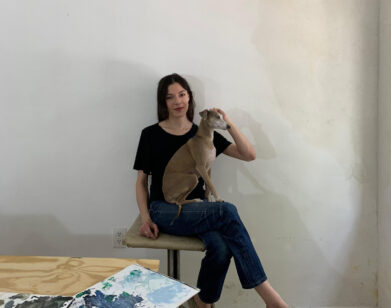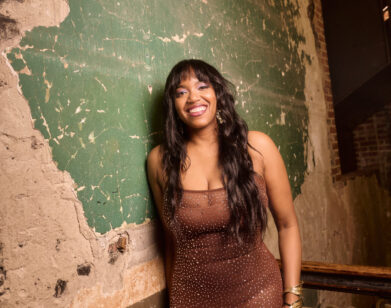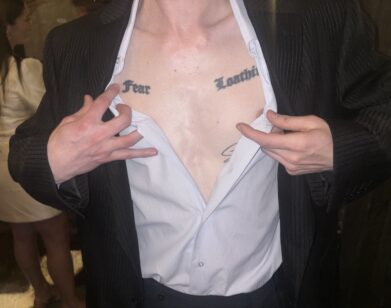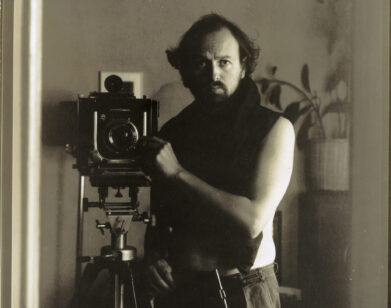Jeppe Hein’s Public Presence
Jeppe Hein has a penchant for placing interactive art in public spaces. Last year, he installed sixteen benches aptly titled Modified Social Benches in Brooklyn Bridge Park as part of an exhibition that encouraged passersby to “Please Touch the Art.” The Berlin-based, Danish artist added a playful spin to the seats—an unsurprising touch considering his previous witty works—by twisting the park benches into infinity loops and slides to create “social sculptures.” As part of the same exhibition, Hein displayed Mirror Labyrinth NY, a formation of mirrors that reflected the viewer and the city, meant to inspire meditations on oneself in relation to one’s surroundings. This June, a similar installation, Semicircular Space, appeared in Melbourne, Australia.
Last month, however, Hein shifted gears, moving from metropolises to mountains—specifically to World’s End, a 251-acre conservation park in Hingham, Massachusetts. The area consists of four oval-shaped hills on two islands connected by a sandbar. Hein’s newest piece, titled New End, rests along the water overlooking Hingham harbor, and is the first-ever art installation to be exhibited on the property.
And it certainly doesn’t disappoint. A labyrinth of reflective columns, New End is an impressive yet unobtrusive structure that almost dissolves into the coastal landscape. Hein’s stainless steel panels range from three to nine feet, mirroring and immersing spectators in their surroundings. The reflections are at once cohesive and fractured, interrupted by crevices between the panes that reveal fellow onlookers in the maze, resulting in a slightly amusing, oddly intimate experience.
Boston-based curator Pedro Alonzo says that the seclusion and stillness of World’s End reminded him of Hein, who believes that dialog with oneself, others, and the environment are central to his art. Alonzo tells us, “I loved that I could work with someone whose intention is that of self-awareness and trying to help people be present.”
We caught up with Hein, who’d just finished doing yoga in the park, at the opening reception in World’s End to talk about mirrors, art, and play.
PIMPLOY PHONGSIRIVECH: I quite like the title New End, but I’m not sure I understand it entirely. Could you talk a bit about its significance?
JEPPE HEIN: I think the name “World’s End” is really interesting. What is it? What is the world’s end? Where? I don’t believe in ends. I think that when something ends there’s something new starting. The name was to inspire people to not believe in ends—”If it’s not good, it’s not the end.” I like that idea.
PHONGSIRIVECH: This particular location is beautiful. In what ways did the landscape inform your piece?
HEIN: I had to find out what people used this place for, and how I could approach it. To create something in an area so beautiful—this landscape—to compete with it was so difficult. So I used these two mountains, those two hills. I got inspired by that. At first it was going to be [installed] further up in the hills, but then we found out that there was water down here. Imagine in the winter when the ice comes up.
PHONGSIRIVECH: And when the leaves start turning.
HEIN: Yes—season is really important because you have these mirror panels. I work a lot with mirrors. People reflect themselves in the work and [it] becomes a tool for communication and dialogue. You bring it out here and you see people walking around taking photos, kids running, everyone being a part of it. Are you outside or inside the work? You don’t really know.
PHONGSIRIVECH: Like an illusion?
HEIN: Yeah. It’s also about your life. Are you inside or outside yourself? I think what we need is to understand each other much more, especially with the whole world right now. We don’t understand each other. That’s why there are so many bad things happening; a lot of it has to do with not understanding. Not that I’m trying to save the world … but I try to do my part and if you can somehow engage with this art piece… If you’re creating a smile in yourself and also giving it to someone else, then you’ve started a dialogue. You also start to play. Of course there’s [such] a thing as too much play, but there’s a fine border. You know Buster Keaton or Charles Chaplin? They were funny but also politically active. I’m not politically active, but I’m saying [that] you can open up people’s understanding of themselves and others with play.
PHONGSIRIVECH: You said that the piece encourages people to find the child within themselves, and earlier Pedro Alonzo mentioned that your family played a large part in creating this piece. Is that true, and how so?
HEIN: Of course. I have three girls myself—one and a half, seven, and ten [years old]. When you start to get influenced by your family, you feel love for someone else and your heart starts to move away from yourself. … When you have children it wakes up the child in you. When you have children, you start to play with them and you mirror yourself. You see your parents in yourself. It’s all about mirroring. My family life mirrors why I am the person I am. We’re all looking for acceptance and love, beginning with our parents. And then when you find [that] out, you start working with yourself, you start to find out that the acceptance and love that you find somewhere else mirrors [you] in all kinds of different situations. That type of love you can only find in one place: in yourself. And many times we’re all looking for it somewhere else.
PHONGSIRIVECH: Jeppe, with these kind of spiritual and philosophical ideas—
HEIN: Facts! [laughs] Sorry I interrupted you. No, they’re facts. I mean, of course they’re philosophical. There’s a philosopher [Finn Janning], who made a book about my burnout. It’s called, The Happiness of Burnout: The Case of Jeppe Hein. He tells my story, but it also references a lot of philosophers. Anyway, I think it’s a fact—but it’s a fact for me. I have to be careful not to generalize everything but for me, it was like that: I was looking for acceptance, love, and that’s why I became present in everything I did. I also realized that I don’t need to be everywhere because my art pieces can talk for themselves.
PHONGSIRIVECH: I feel like given how secluded this area is, it lends itself to communicate those introspective ideas as opposed to your previous pieces, like the one in Brooklyn Bridge Park.
HEIN: That was quite different, yes. That was more about reflecting skyscrapers—a lot of things [were] happening at once.
PHONGSIRIVECH: Right. It’s definitely less chaotic here.
HEIN: Yes, and I’ve become much more spiritual and use a lot of energy to try and keep the balance. I just did yoga up there. I take the time for that. We’re in a society, I think, where everyone thinks it’s so cool to work, it’s so cool to be online, so cool to be super busy. I think it’s super cool not to be busy. I think that this media online stuff makes us all sick. We think we have to be online all the time.
PHONGSIRIVECH: And connected.
HEIN: And connected, yes. Of course it’s nice to be connected, but the nicest thing, I think, is someone you can look in the eye and talk to.
A NEW END IS ON VIEW AT WORLD’S END IN HINGHAM, MASSACHUSETTS AS PART OF THE ART AND THE LANDSCAPE SERIES PRESENTED BY THE TRUSTEES OF RESERVATIONS THROUGH OCTOBER 2017. FOR MORE ON JEPPE HEIN, VISIT HIS WEBSITE.

